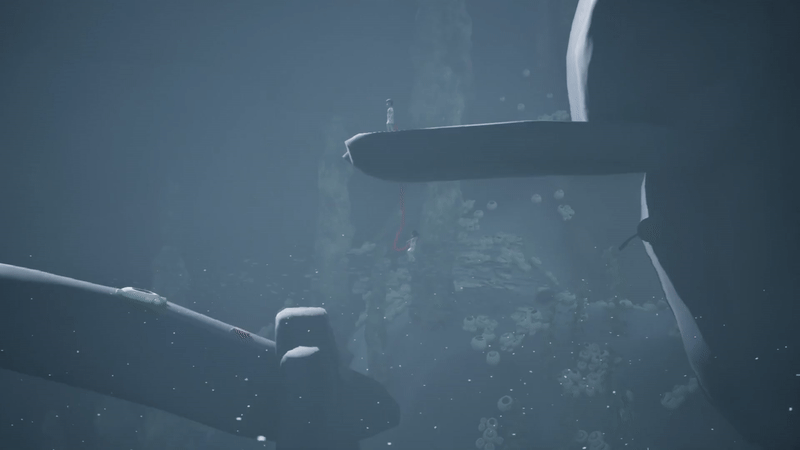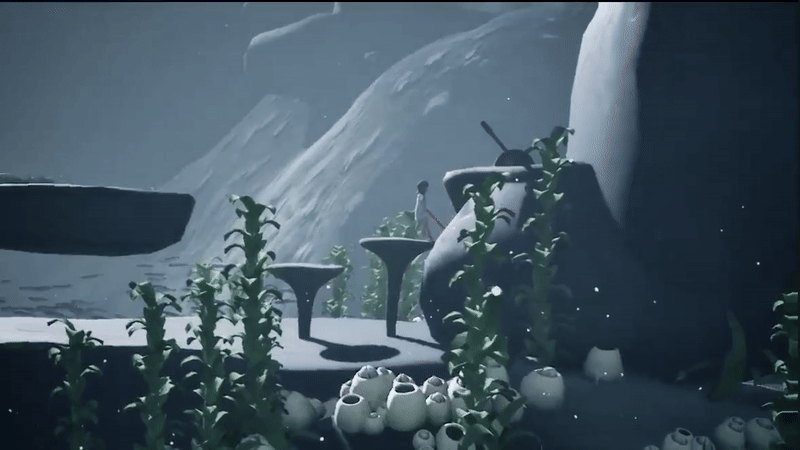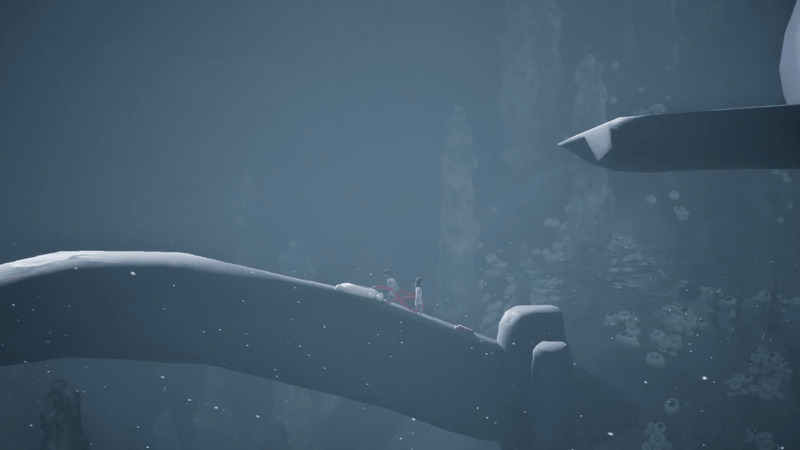
Ellie Tsamouli
Level Designer
BLOODBOUND
INTRODUCTION
This is was a group project aiming to create a game with the theme "It's dangerous to go alone". My responsibilities included:
designing the intermediate level
reinforcing the mechanics through level design
provide room for narrative
8 Weeks
11 People
Unreal Engine
Perforce
Jira
Pre-Production
During this stage, the team established the core mechanics, genre and narrative. Understanding them was essential for my process to create cohesive levels that complemented the gameplay.

Narrative
In this game you embark on the journey of the twins torwards their birth. The ambilical cord always connecting them. Will they be able to make it?

Mechanics & Level Interactables
Since this game is a co-op puzzle game, talking about the mechanics and level interactables is essential before diving into the level design. Here are our tools:

Swinging: One player holds and the other one swings.

Levers: They can be used with either bubbles or airways.

Buttons: They can be used with either bubbles or airways.

Airways: Players can use it to get a boost. It can be activated or just exist.

Bubbles: They carry players for point A to point B. The need to be activated.
References and Locations
Before going into sketching the puzzles and map, I referenced similar titles to analyze key elements such as camera angles, prominent shapes, and overall design language. This not only helped me identify effective visual and gameplay patterns but also deepened my understanding of the genre. As always, I created a reference board to organize my findings.



2D Puzzles
When designing the puzzles for this game, I had three key factors to consider beforehand:
Narrative Tools Difficulty


In order to make the puzzles and areas I took the script line by line and noted words or phrases I could translate using a variation of the mechanics. I also considered that this would be the intermediate level, right after the onboarding, therefore the should be an exponential increase in difficulty and complexity of the puzzles. For the sake of time we will do the 5 most notable ones.
Anomalies

When thinking about this puzzle, the first thing that came to mind was things feeling a bit... "strange".
Using a "catapult" that was just an accelerated crusher and having the lever positioned sideways were small puzzle details that would add to the strangeness of this section.
Another idea was using the boxes as a foam pit, reminiscent of childhood and playfulness.
Two Instruments of Creation
_edited_edited.jpg)
With this one, I immediately thought of duality and the power of two people helping each other. Two crushers, two islands, two people trying to pass through.
I wanted this to be a synchronization puzzle, since it was before the "boss fight" and that would require the upmost collaboration and understanding.
Not Fit To Walk This Path
This puzzle was a more relaxed and easy puzzle since it was right after "Anomalies", to bring the tension down and give players a moment to breath and traverse.
To make it easy but satisfying, I thought of presenting all the information infront of the player so they made an instant connection.
If I was able to remake this puzzle now, I would put the retrieving box more forward, so they can immediatly know what that button did.

Eel Baiting

At the end of "Part Two" and right before the final level, the twins encounter an Eel that had been stalking them. In order to move on they need to defeat it.
First the twins bait the Eel, then they have some time while it searches for them to quickly push a rock on it.
I though this part was great tension builder and a lovely co-op moment.
No Eels were harmed during this process!
2D Map
To assemble the map I took an unconventional approach to my design. Speaking with the narrative designer, we decided what line worked best as a puzzle or traversal sequence. In some cases, lines were also combined. It was my responsibility to connect them in a cohesive and structured way. So the map looked like this:

The intention during this level was to:
Introduce complexity gradually
Support the narrative
Exercise player's abilities
Make it Fun
Production
In this section we will talk about my process as a level designer during production. After all the components and characteristics of the game had been placed it was time for me to start with the grayboxing and blockout.
Blockout & Grayboxing
Blockout was a very special process for me during this game, since it was my first time making a 2.5D game. It required a lot of learning and testing for everyone in the team. I am especially proud of how we handled this task. This was my process.
Workflow
General Shape Layout

Firstly I made a generalized layout with prominent shapes, but what was interesting is that all the shapes used needed to have a certain depth. The players would be always moving in one axis at the same exact location. So, even just assembling the blocks needed to be done meticulously.
Blockout
Once I pinpointed the basic shape, I started blocking out the puzzles. This is where the most changes happened, because suddenly I had all the components down. The length of the rope, how moving cubes behaved, how swinging felt etc.

We also set up the side scrolling camera, covering a certain angle. Setting up the puzzles in coordination with the camera was crucial to insure that the player had all the information presented infront of them to in order to progress.
Setdressing

Even though we had artists, due to the large workload and time constraints, the level designers took on the task of setdressing the puzzles.
We closely worked with artists, so they could point us to their vision, explain the tools and review the result afterwards.
This was a great experience,as it allowed for faster iteration, ensured the visuals aligned closely with gameplay needs, and it gave us designers more control over the player's experience.
Iterations
It is important to note that none of the puzzle sketches made it exactly as I innitialy designed. Rather they were stripped down to their core mechanics and intention.Therefore, iteration played a crucial role to this project. Let's see in which ways:
Refining Levels and Iteration
Iterations happened at various stages of the project, but I think it is more constructive for this game to talk about specific problems and solutions about flow and complexity.
Pacing and Flow

One of the early problems of the level was the spacing between the puzzles.
The player didn't digest their victory before being presented with a different problem, and that made it more frustrating and less fun.
Since we didn't have many traversing space, narrative also felt clammed and forced.
In order to fix that, I opened up the spaces and swapped puzzles with enviromental storytelling.
I also added small platforming sections that felt playful and natural, so players could still feel the game without getting bored


This iteration added so much to the game.
Instead of having an overwhelming amount of puzzles players could still practice the mechanics without feeling overwhelmed or bored.
They even got better at solving the puzzles, since they weren't cramped and tired.
Complexity scaling
When it came down to complexity is where we had the most iterations.Going from paper to engine is much more different.
Almost all my initial puzzles were either too complex or did not work with the engine's restrictions. So I had to get creative and find a way to stay true to the intention but make them more intuitive.


First I stripped them down to their core mechanics. What made them fun, interesting, challenging?
Then I simplified them to their core. If the player could solve a simplified version too easily, I made it a bit more complex. If it was too complex vice versa.
Sometimes it is hard to know how complex is a design is until you have to explain it to someone else. so testing, asking really played a big during this part.
At the end the puzzles felt simpler, more intuitive and ultimately more fun. Making the player feel smart is really important in any game, and that is something I am really lucky to have known.

Reflection
This game was undoubtedly overscoped, but I am really proud of it. It was my first level design project within a team and the beginning of a journey I’m excited about. It truly solidified my love for the craft and taught me valuable lessons about flow, game balance, and complexity.
Looking back with the knowledge I have now, I would change a few things in my process that would have made my work much easier. I would document my changes more thoroughly to maintain a steady flow of non-verbal communication with my team, and I would work with a blockout pack. Both of these adjustments would have saved me many extra hours of development.
All in all, it was a great learning experience collaborating with different disciplines and gaining a deeper understanding of their pipelines. Knowing how to communicate effectively across disciplines is a crucial skill for a designer, ensuring we can successfully carry the vision of the game.